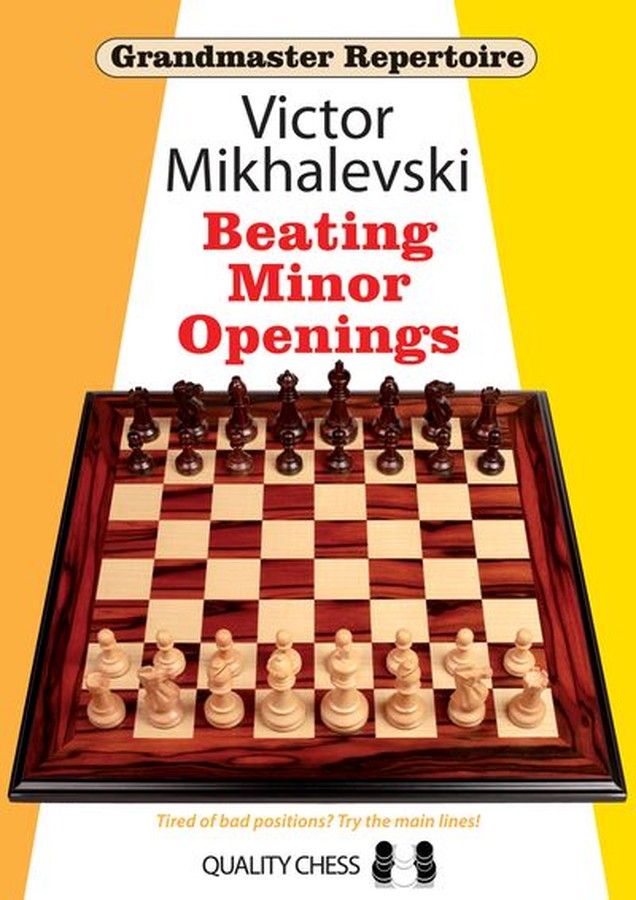| Utgivelsesdato | Oktober 2016 |
| Forfatter | |
| Pris | 305 NOK |
GM Repertoire 19: Beating Minor Openings
En stor og grundig ny bok som gir svart repertoar mot alle hvits åpningstrekk utenom 1 e4 og 1 d4. Mikhalevski foreskriver direkte kamp om sentrum og velger bl.a. de populære oppskriftene 1 c4 e5 2 g3 c6 og 1 Sf3 d5 2 c4 d4.
Forlagets egen omtale
Beating Minor Openings offers a world-class repertoire for Black against every sensible first move apart from 1.d4 and 1.e4.
GM Victor Mikhalevski advocates an ambitious approach for Black, with the aim of occupying the centre and fighting for an advantage, rather than mere equality, wherever possible.
The most critical moves covered are 1.c4 and 1.Nf3. Against the latter, Mikhalevski supplies a range of replies to allow for transpositions to most queen’s pawn openings.
In a review of Mikhalevski’s previous book for Quality Chess, IM John Cox commented: “Given the goal the book has set itself, I don’t believe the job could have been done better.”
Fra forfatterens innledning i boka
How does one go about constructing a repertoire against a vast assortment of irregular opening systems? When writing this book, I generally relied on the rule that if White does not occupy the centre with his pawns, then Black should take the opportunity to do so himself. I have therefore chosen to recommend active, space-gaining options for Black, without descending into over-the- top aggressiveness.
The contents of this book have been grouped into five main sections, as summarized below.
Before going into details though, I would like to say a little bit about a theme that crops up time and time again in this book.Reversed Openings
Several parts of the book will see us playing a standard opening with reversed colours and a
tempo less. Actually, if we assume that White plays something other than 1.d4 or 1.e4 and Black plays ...d5 and/or ...e5, then White is almost certain to be playing some sort of recognizable
Black defence with an extra tempo. Generally I consider this a healthy way to play with Black – although an obvious caveat is that we must avoid extremely sharp variations where the opponent’s extra tempo could come with maximum impact. Instead we will play actively but cautiously,
with the aim of reaching a position where the extra tempo isn’t so relevant. Such positions tend to be objectively equal – but it’s a comfortable form of equality for Black, as he will effectively be playing as White, often with a slight space advantage to build upon.If White plays a reversed opening which allows you to establish an ideal centre with pawns on d5 and e5, then you should almost always take that opportunity. However, it quite often happens that White will allow you to play one of these moves but not the other. For example, in this book I recommend meeting 1.c4 with 1...e5, and 1.f4 with 1...d5. Should a dedicated 1.d4 player feel wary about facing a Sicilian Defence with reversed colours and a tempo less? Will a 1.e4 fan be uneasy playing against the Dutch Defence under the same circumstances? (There are many other examples of a similar theme.)
I actually don’t see this as a problem at all. As I mentioned earlier, we will be avoiding any
super-sharp variations where White’s extra tempo will make a big difference. Instead, Black can simply enjoy the luxury of having a firm foothold in the centre, and he will go on to develop his pieces on natural squares. Even if we have to play a bit more conservatively than we would on the white side of the opening, we should still be able to reach a comfortable position, often with chances to press for a slight advantage. A strong player should possess enough ‘chess culture’ to handle positions and structures which lie outside of his normal repertoire. Victor Mikhalevski is the reigning Israeli Champion and is renowned as a leading theoretician.
| Innbundet? | Nei |
| Type | Bok |
| Språk | Engelsk |
| Antall sider | 584 |
Produktet er en del av serien Grandmaster Repertoire
Denne serien av åpningsbøker fra forlaget Quality Chess har faktisk satt en ny standard som grundige og ganske omfattende bøker fra ledende kapasiteter på de ulike åpningene. Stoffet er skrevet for å ha relevans hos lesere helt opp på stormesternivå, men bøkene er også godt nok presenterte til å nå et publikum et godt stykke nedover i rekkene av alminnelige spillere også med rating ned mot cirka 1400.

